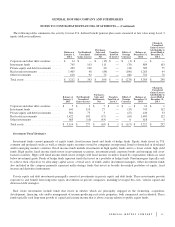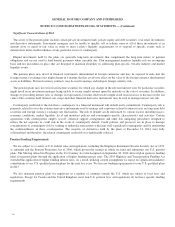General Motors 2014 Annual Report Download - page 104
Download and view the complete annual report
Please find page 104 of the 2014 General Motors annual report below. You can navigate through the pages in the report by either clicking on the pages listed below, or by using the keyword search tool below to find specific information within the annual report.
GENERAL MOTORS COMPANY AND SUBSIDIARIES
NOTES TO CONSOLIDATED FINANCIAL STATEMENTS — (Continued)
Estimated amounts to be amortized from Accumulated other comprehensive loss into net periodic benefit cost in the year ending
December 31, 2015 based on December 31, 2014 plan measurements are $295 million, consisting primarily of amortization of the net
actuarial loss in the non-U.S. pension plans.
Assumptions
Investment Strategies and Long-Term Rate of Return
Detailed periodic studies conducted by outside actuaries and an internal asset management group are used to determine the long-
term strategic mix among asset classes, risk mitigation strategies and the expected long-term return on asset assumptions for the U.S.
pension plans. The U.S. study includes a review of alternative asset allocation and risk mitigation strategies, anticipated future long-
term performance and risk of the individual asset classes that comprise the plans’ asset mix. Similar studies are performed for the
significant non-U.S. pension plans with the assistance of outside actuaries and asset managers. While the studies incorporate data
from recent plan performance and historical returns, the expected long-term return on plan asset assumptions are determined based on
long-term prospective rates of return.
The strategic asset mix and risk mitigation strategies for the plans are tailored specifically for each plan. Individual plans have
distinct liabilities, liquidity needs and regulatory requirements. Consequently there are different investment policies set by individual
plan fiduciaries. Although investment policies and risk mitigation strategies may differ among plans, each investment strategy is
considered to be appropriate in the context of the specific factors affecting each plan.
In setting new strategic asset mixes, consideration is given to the likelihood that the selected mixes will effectively fund the projected
pension plan liabilities, while aligning with the risk tolerance of the plans’ fiduciaries. The strategic asset mixes for U.S. defined benefit
pension plans are increasingly designed to satisfy the competing objectives of improving funded positions (market value of assets equal
to or greater than the present value of the liabilities) and mitigating the possibility of a deterioration in funded status.
Derivatives may be used to provide cost effective solutions for rebalancing investment portfolios, increasing or decreasing exposure
to various asset classes and for mitigating risks, primarily interest rate and currency risks. Equity and fixed income managers are
permitted to utilize derivatives as efficient substitutes for traditional physical securities. Interest rate derivatives may be used to adjust
portfolio duration to align with a plan’s targeted investment policy. Alternative investment managers are permitted to employ
leverage, including through the use of derivatives, which may alter economic exposure.
In December 2014 an investment policy study was completed for the U.S. pension plans. The study resulted in new target asset
allocations being approved for the U.S. pension plans with resulting changes to the expected long-term rate of return on assets. The
weighted-average long-term rate of return on assets decreased from 6.5% at December 31, 2013 to 6.4% at December 31, 2014. The
expected long-term rate of return on plan assets used in determining pension expense for non-U.S. plans is determined in a similar
manner to the U.S. plans.
Target Allocation Percentages
The following table summarizes the target allocations by asset category for U.S. and non-U.S. defined benefit pension plans:
December 31, 2014 December 31, 2013
U.S. Plans Non-U.S. Plans U.S. Plans Non-U.S. Plans
Equity ........................................................... 16% 27% 19% 28%
Debt ............................................................. 60% 47% 58% 49%
Other (a) .......................................................... 24% 26% 23% 23%
Total ............................................................. 100% 100% 100% 100%
104
























